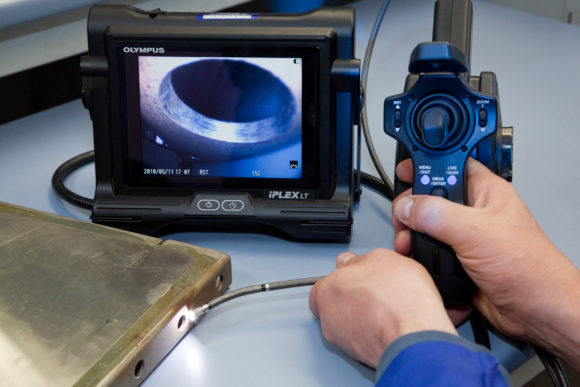Non-destructive testing
What is meant by non-destructive testing?
Non-destructive testing (NDT) enables materials, components and constructions to be examined without permanently changing the objects under examination. Material defects are mainly examined according to the following principles:
- surface defects
a. Inspection of mechanical and optical quality characteristics by perceiving, comparing, estimating, counting and measuring.
b. Crack detection by the liquid penetrant method
c. Investigation of material inhomogeneities in areas close to the surface by analysing the interaction of the component with electromagnetic fields or optical radiation - volume defects
a. Investigation of material inhomogeneities by means of transmission with X-rays or gamma rays

Range of services of our materials testing laboratory
Our materials laboratory has the testing devices and equipment for various standard-compliant tests in the field of visual testing (VT), dye penetrant testing (PT), magnetic particle testing (MT) and radiographic testing (RT). Qualified and certified level 3 personnel are available in each of the processes mentioned.
| Procedure | Testing devices / equipment |
|---|---|
| VT | Video endoscope (Ø 6mm), welding seam gauges, length measuring equipment |
| PT | mainly red-white testing (IICd) |
| MT | Hand magnet, high current generator with coils, mainly fluorescent |
| RT | mobile X-ray tube up to 300 kV, mobile film developer |
Test lexicon
In the following table you will find some abbreviations for standardised designations.
| Abbreviation | Meaning |
|---|---|
| NDT | Non-destructive testing |
| VT | Visual testing |
| PT | Penetration testing |
| MT | Magnetic particle testing |
| RT | Radiographic testing |
What are the advantages of non-destructive testing?
Non-destructive material testing can be used to detect production-related or operational defects, but also to check specified material properties without impairing the usability of the component. Use our non-destructive tests for the complete routine testing of individual parts and thus obtain a higher degree of reliability than with a random sample test!
Are you in need of non-destructive testing?
We would gladly support you. Contact us for testing.